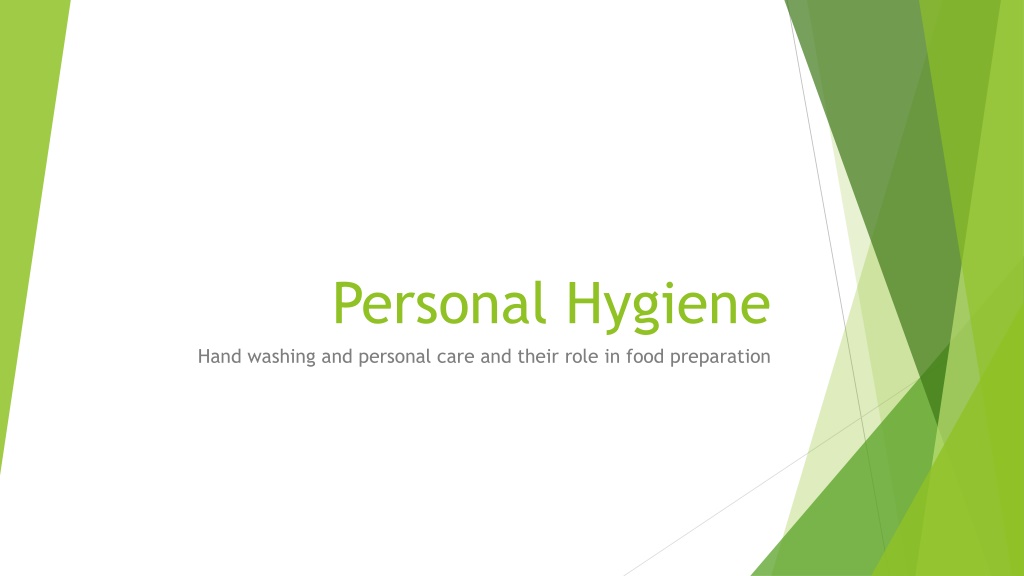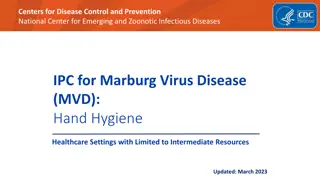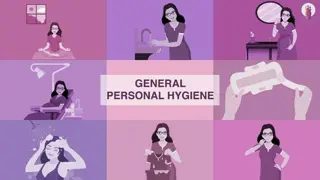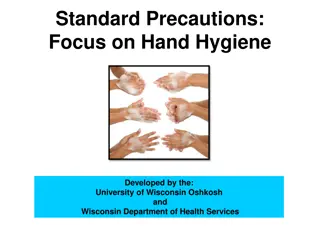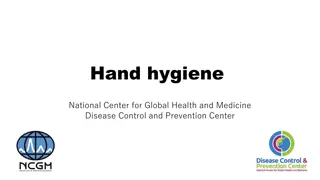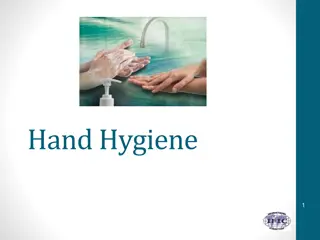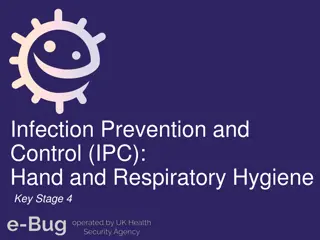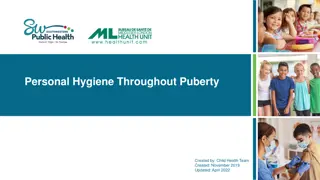Personal Hygiene
Proper hand washing and personal care are essential in ensuring food safety. This article delves into the significance of maintaining good hygiene practices during food preparation to prevent contamination and maintain the overall health and well-being of individuals.
Download Presentation

Please find below an Image/Link to download the presentation.
The content on the website is provided AS IS for your information and personal use only. It may not be sold, licensed, or shared on other websites without obtaining consent from the author.If you encounter any issues during the download, it is possible that the publisher has removed the file from their server.
You are allowed to download the files provided on this website for personal or commercial use, subject to the condition that they are used lawfully. All files are the property of their respective owners.
The content on the website is provided AS IS for your information and personal use only. It may not be sold, licensed, or shared on other websites without obtaining consent from the author.
E N D
Presentation Transcript
Personal Hygiene Hand washing and personal care and their role in food preparation
Vocabulary Hygiene a condition or practice conducive to the preservation of health Microorganisms any organism too small to be viewed by the unaided eye (bacteria, some fungi, algae, etc.) Cross contamination a condition of impurity resulting from the transfer of microorganisms, like bacteria, from one source to another Groom to make neat or tidy (clean, brush, etc.) Protective clothing apparel such as gloves, apron, etc., used to minimize contamination and/or protect clothing Cleanliness a state of personal neatness
When to wash your hands When they are soiled After other cleaning activities When arriving at work After smoking When changing the foods handled After handling raw meat When switching tasks After eating After handling money After blowing your nose After handling dirty dishes Before wearing gloves After being in the restroom wash twice once in the restroom and again in the workplace After wearing gloves After handling garbage cans After mopping and sweeping
Places with the most germs: Work desk Escalator handrails Kitchen sink Shopping cart handles Dishcloth Picnic tables Sponge Pens, pencils and crayons Garbage can Remote controls Refrigerator Light switches Phones Bathroom cups Bathroom doorknob Pet cages Keyboards Toys
Avoid Sneezing, coughing into the hands (use inside elbow) Picking your nose Touching your face or hair Scratching your head Grazing while preparing food Double dipping Handling food when sick
Do Grasp equipment by the handle Hold glasses at the bottom, not the rim area Carry plates without fingers touching the top of the plate Use a disposable towels for drying hands Wear clean clothes to work Keep your long hair properly tied and covered When refilling a person s drink, keep pitchers from toughing the glass or liquid in the glass
The Big 5 If you are sick you should never handle food. You risk infecting others. Stay home if you have: Hepatitis A Salmonella Shigella E.Coli (Escherichia coli 0157:H7) Norovirus
The Big 5 Easy to remember! Send Sick Employees Home Now Shigella Salmonella E.Coli Hepatitis A Norovirus
The Big 5 Symptoms include (But are not limited to): Vomiting Fever Diarrhea Jaundice Sore throat with a fever
5 practices of good personal hygiene and health 1. Hygienic Hand Practices http://www.flickr.com/photos/arlingtonva /4314530838/ 2. Maintain Personal Cleanliness http://www.flickr.com/photos/minnellium/42141 27988/ 3. Wear clean and appropriate uniforms http://www.flickr.com/photos/usarmyafri ca/4457105066/ 4. Maintain Good Health http://www.flickr.com/photos/mikebaird/32396 27157/ 5. Report Illness http://www.flickr.com/photos/spcbrass/369210589/
Maricopa County 6 step Hand Washing Procedure 1. Moisten hands with warm water 2. Apply hand soap 3. Vigorously rub hands together scrubbing between your fingers, under fingernails, your forearms, and the backs of hands. Continue scrubbing for at least 10-15 seconds. It is the hand soap combined with the scrubbing action that removes the dirt, bacteria, and virus from the hands.
Maricopa County 6 Step Hand Washing Procedure 4. Completely rinse your hands under warm running water for the remaining 5-10 seconds. 5. Dry hands with a paper towel. 6. Turn off the faucet with the same paper towel used to dry your hands. It is a good idea to use the paper towel to open the door when leaving the bathroom.
Maricopa County 6 Step Hand Washing Procedure Step 3 and 4 equals 20 seconds! This is the time it takes to sing a nursery rhyme twice like the ABCs With a partner make a list of as many nursery rhymes as you can think of in 30 seconds.
Germ Facts Some microorganisms are good for you, and some are bad. The bad ones, specifically bacteria, are microscopic, so you can t see them with the naked eye. Some microorganisms are used for making bread, beer, and yogurt.
Germ Facts Germs are tough. Viruses can be transferred from dry smooth surface up to 20 minutes after being contaminated. E. Coli, salmonella and other bacteria can live up to two hours on surfaces like doorknobs, keyboards, and tables. Viruses can travel on droplets through the air.
Germ Facts 229,000 germs per square inch on frequently used faucet handles. 21,000 germs per square inch on work desks about 400 times more than the average toilet seat. More germs at the kitchen sink than at the toilet. 1,500 on each square centimeter of hands.
Germ Facts Bacteria doubles every 20 minutes. Five bacteria in a sandwich at noon will total over 10 million by 7 pm. After three days, with no bacteria dying, there would be enough to cover the earth. Microorganisms can build up resistance to drugs intended to kill them.
Germ Facts Freezing can slow down bacteria growth Temperatures over 140 degrees can kill germs.
Fact If you shake hands with someone who has just come from the bathroom without washing his or her hands, there is a one in three chance of getting germs from that person s feces in your mouth within two hours.
Got it? Lets try it. Everyone go wash your hands!
